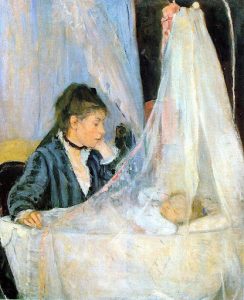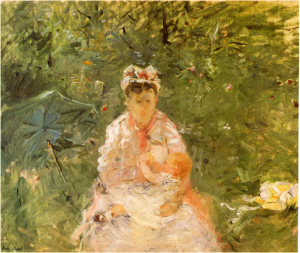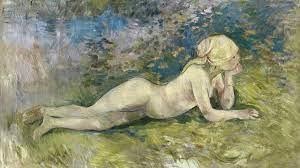Morisot and her sister, both born in 1841, received the typical art education for their class. A copyist at the Louvre, she met the famous Barbizon painter Camille Corot. Corot inspired Morisot to paint ‘en Plein Air (outdoors), a style now associated with the Impressionist movement. She met Manet and introduced him to the Impressionists in 1868. She also persuaded Manet to paint ‘en Plein air’ a style different from his usual. Manet’s portraits of Morisot from this era are a modern, spontaneous vision of fashionable beauty. Manet often posed Morisot with fashionable accessories like fans, veils, and slippers.
The Beginning
 Morisot was the model for Edouard Manet, a famous 19th-century modernist painter, appearing in works like ‘The Balcony’. She was also married to his famous younger brother (Eugène Manet). Morisot was a distinctive and dedicated artist, not just a model. Her friendship with Manet was mutually beneficial, inspiring each other’s work. Morisot was a well-known French painter and the Salon jury in Paris at that time recognizes her works. She was the only female in Edgar Degas’ first Impressionist exhibition and took part in seven more.
Morisot was the model for Edouard Manet, a famous 19th-century modernist painter, appearing in works like ‘The Balcony’. She was also married to his famous younger brother (Eugène Manet). Morisot was a distinctive and dedicated artist, not just a model. Her friendship with Manet was mutually beneficial, inspiring each other’s work. Morisot was a well-known French painter and the Salon jury in Paris at that time recognizes her works. She was the only female in Edgar Degas’ first Impressionist exhibition and took part in seven more.
However, the art world never took her as seriously as most impressionist artists. Co-curator Sylvie Patry told Artsy in an email that people viewed her subjects as mere expressions of her gender, more than contemporary themes or portrayals of a new urban conventional lifestyle. She depicted her life as a wealthy wife and mother and a symbol of the ‘modern woman,’ says Manet, her brother-in-law and fellow impressionist.
Life and Work
 In roughly a third of her works, Morisot depicted women and children in their houses, parks, and her daughter Julie. Morisot painted lovely and delicate themes with a bold interpretation but neglected. She focused on the female viewpoint, gestural brushstrokes that border on abstraction, and unfinished canvas edges.
In roughly a third of her works, Morisot depicted women and children in their houses, parks, and her daughter Julie. Morisot painted lovely and delicate themes with a bold interpretation but neglected. She focused on the female viewpoint, gestural brushstrokes that border on abstraction, and unfinished canvas edges.
Morisot’s paintings owe a lot to fashion. An example is her most famous work, ‘The Cradle,’ where everything from the mother’s clothing to the beautifully draped crib reflects contemporary taste. In many minds, it represents domestic bliss and tranquillity. The abundance of white drapery and the mother’s wistful gaze give the painting a gloomy and enclosed air.
 She also painted ‘Wet Nurse’ (1879), which depicts one of the strangest, if not the most extraordinary, situations in art history: a woman painting another woman nursing her baby. The painting appears to be a more subdued version of Madonna and Child.
She also painted ‘Wet Nurse’ (1879), which depicts one of the strangest, if not the most extraordinary, situations in art history: a woman painting another woman nursing her baby. The painting appears to be a more subdued version of Madonna and Child.
 Morisot also reinterpreted the toilette rituals of women’s bathing, dressing, and applying makeup. For male artists, this genre was a way to show women in various stages of undress. Morisot’s paintings focus on the subjects’ inner experiences rather than the nude. Introspection and being self-absorbed are themes that run throughout her work; she depicts women in various ways. In contrast to most impressionists artists, Morisot’s uneven brushwork covers any nude appearance. Her use of rich paint, rather than the figures themselves, contributes to their sensuality.
Morisot also reinterpreted the toilette rituals of women’s bathing, dressing, and applying makeup. For male artists, this genre was a way to show women in various stages of undress. Morisot’s paintings focus on the subjects’ inner experiences rather than the nude. Introspection and being self-absorbed are themes that run throughout her work; she depicts women in various ways. In contrast to most impressionists artists, Morisot’s uneven brushwork covers any nude appearance. Her use of rich paint, rather than the figures themselves, contributes to their sensuality.
Later life and legacy
Morisot’s career flourished after her 1874 marriage to Manet’s brother Eugene. At the Hotel Drouot auction in 1875, she had already won the patronage of Paul Durand-Ruel (the National Gallery’s exhibition). Like the portraits of her daughter Julie, her later work shows a looser style of happy, vibrant works that reflect a creative life. Morisot seems to embody the contradictions of being a woman in late 19th century Paris; free-spirited and dedicated to her art, but also aware of her place in society and the rules of that life.
Despite all her contributions to art, Morisot’s death certificate reads, “unemployed”. Meanwhile, the street where Morisot built her house and lived in her lifetime was named after her niece’s husband (Paul Valéry, a French poet and philosopher), who inherited her house. On the other hand, Morisot was no amateur; her contributions to art history are slowly being resurrected, showing twisted and reversed viewpoints of the feminine mundane in lovely pink and grey paint strokes.

Recent Comments